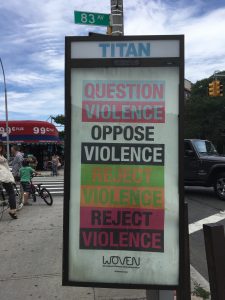I am a new-ish vegan, a feature of my existence that I consider to be less of an identity and more of a commitment. I don’t eat meat, dairy, eggs, honey, or anything else that comes from animals (to my knowledge – this is a looooong process of learning about animal exploitation, the differences between animal activism and animal welfare, the racialized dimensions of veganism and frictions in the pursuit of intersectionality and/or unity, and so on), and I am reading and learning a lot about the political philosophy, environmental philosophy, and cultural anthropology dimensions of such a conversation. Needless to say, it is a lot.
One place many scholars, animal activist and otherwise, continue to push and explore is the question of violence. (For an interesting ongoing exploration of this topic, check out Histories of Violence‘s short video clips of eminent scholars and public thinkers on the subject.) Concerns about this question vis-à-vis human beings have emerged from mass violence in times of war and genocide, individual violence in the case of sexual assault and domestic abuse (though one can easily make connections between individual cases of violence and broader structural violences that inform and support these cases), systemic/symbolic violence (as in the case of silencing in research, which I am currently deeply interested in, or in the case of inequitable testing and educational practices in public schooling which disadvantage certain groups of historically oppressed young people), and so on.
Yet when we turn to the question of violence against animals, the conversation becomes very complicated. This form of violence has been imbricated in our social existence at all levels of human experience: food, religion, entertainment and sport, clothing, protection, research, even our definition of home and domestic life. Non-human animals – which is the term many animal activists use, as they argue there is no inherent distinction between human and non-human beings under the general heading of “animals” – have, according to most human cultural traditions, existed to serve, sustain, accompany, and protect us. While it may seem like an emotional plea to approach this conversation by using terms like “violence,” it’s actually important to consider the fact that the exploration of violence as a topic of study in political science, anthropology, sociology, critical race studies, feminist and gender studies, postcolonial studies, queer studies, and philosophy is far from over. And very few of the scholars considering these topics, including Hannah Arendt, Franz Fanon, Gayatri Spivak, Homi Bhabha, Edward Said, and many others are taking a purely emotional tack (though emotion plays a powerful role in one’s ability to reason). Violence is a universal topic, in fact, in all of our lives, and different scholars and disciplines approach this from different histories and toward different objectives. I would not, for example, argue that the symbolic violence of silencing Black and Brown students in public schools via monolingual/U.S.-centric pedagogy is the same as sexual violence. Yet one of the possible functions of violence – to reinforce the power of the ruling class, group, or individual in a given social context – is very much shared by both examples.

And thus I come to my point. Rather than deliver an annotated bibliography of scholars who have written about violence and the relationship between human and non-human animals, I simply want to reflect on the meaning of a sign like this one on a street near where I live in Queens. Yes, we could all quite easily say that we agree, we should reject, question, and oppose violence. But what about the violences that have become so normalized that we don’t see them as such? I have a good friend who is deeply committed to anti-racist pedagogy and education in public schools. And he makes a real difference with his students. Yet he chomps on chicken without a second thought. (Actually, to be fair, we did talk about animal agriculture while he was eating, and he did state that he could become vegetarian, though he just couldn’t go all the way and become vegan.)
I’m not writing to rant about hypocrites. I am also one, as are all of us to some degree as a condition of participating in today’s society and political economic system. However, the stopping-of-thinking is the place where I want to suggest the seeds of violence remain underground, untilled, unmoved, and free to bloom into new forms as late-stage capitalism moves forward and we demand more and more animals for consumption, commodification, exploitation, and entertainment as an ineluctable requirement of “the way things just are.”
Yes, violence is a part of the way things are. But in the past we’ve made choices and changed our relationship to violence – whose potential always lies within us and around us – in different ways. We have pursued legislation and legal cases that have, some might argued, reduced abuses and oppressions in ways demanded by the sociopolitical times. What might lie ahead in terms of environmental violence (and environmental racism, which is an indirect result of this violence) or violence in a systematized form in the case of corporatized animal agriculture? Might we start to rethink the keeping and breeding of animals as pets, or their (ab)use in medical trials and scientific research? Could we consider that this keeps humans in a position of power that we’ve always assumed is “normal” but in reality generates potentially troubling consequences?
I don’t say any of this is easy or even possible yet. The point I’m making is, we’re not talking about this with the framework of violence in hand. The concern I put forward is that not doing so so perpetuates the problem, the many violences without name or demand for redress, and maintains the veneer that status quo is unavoidable. As in all questions about this bizarre and hard time, I hope that is not the case.

